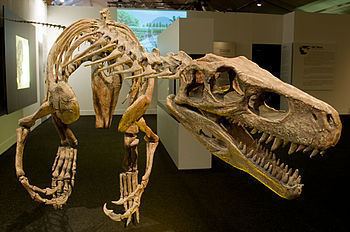Kingdom Animalia Clade Dinosauria Suborder Theropoda Higher classification Theropods | Phylum Chordata Order Saurischia Scientific name Herrerasauridae Rank Family | |
 | ||
Lower classifications Herrerasaurus, Staurikosaurus | ||
Herrerasaurids are among the oldest known dinosaurs, appearing in the fossil record 231.4 million years ago (Late Triassic). They became extinct by the end of the Triassic period. Herrerasaurids were small-sized (not more than 4 metres (13 ft) long) carnivorous theropods or basal saurischians. The best known representatives of this group are from South America (Brazil, Argentina), where they were first discovered in the 1960s. A nearly complete skeleton of Herrerasaurus ischigulastensis was discovered in the Ischigualasto Formation in San Juan, Argentina, in 1988. Less complete herrerasaurids have been found in North America, and they may have inhabited other continents as well.
Contents
Herrerasaurid anatomy is unusual and specialized, and they are not considered to be ancestral to any later dinosaur group. They often present a mixture of very primitive and derived traits. The acetabulum is only partly open, and there are only two sacral vertebrae, the lowest number among dinosaurs. The pubic bone has a derived structure, being rotated somewhat posteriorly and folded to create a superficially tetanuran-like terminal expansion, especially prominent in H. ischigulastensis. The hand is primitive in having five metacarpals and the third finger longer than the second, but clearly theropod in having only three long fingers, with curved claws. Herrerasaurids also have a hinged mandible like all theropods.
ClassificationEdit
Where herrerasaurids lie on the early dinosaur evolutionary tree is unclear. They are possibly basal theropods or basal saurischians but may in fact predate the saurischian-ornithischian split. Early researchers even proposed that they represented an early lineage of sauropodomorphs. Some analyses, such as Nesbitt et al. 2009, have found Herrerasaurus and its relatives in Herrerasauridae to be very basal theropods, while others (such as Ezcurra 2010) have found them to be basal to the clade Eusaurischia, that is, closer to the base of the saurischian tree than either theropods or sauropodomorphs, but not true members of either. The situation is further complicated by uncertainties in correlating the ages of late Triassic beds bearing land animals.
Other proposed members of the clade have included Sanjuansaurus from the same Ischigualasto Formation of Argentina as Herrerasaurus, Staurikosaurus from the Santa Maria Formation of southern Brazil, Chindesaurus from the Upper Petrified Forest (Chinle Formation) of Arizona, and possibly Caseosaurus from the Dockum Formation of Texas, although the relationships of these animals are not fully understood, and not all paleontologists agree. Niedźwiedzki et al. (2014) described a European member of the group on the basis of Norian fossils discovered in Poland. Other possible basal theropods, Alwalkeria from the Late Triassic Maleri Formation of India, and Teyuwasu, known from very fragmentary remains from the Late Triassic of Brazil, might be related.
PhylogenyEdit
Novas (1992) defined Herrerasauridae as Herrerasaurus, Staurikosaurus, and their most recent common ancestor. Sereno (1998) defined the group as the most inclusive clade including H. ischigualastensis but not Passer domesticus. Langer (2004) provided first phylogenetic definition of a higher level taxon, Herrerasauria, as Herrerasaurus but not Liliensternus or Plateosaurus. According to current phylogenetic studies, all of these definitions describe the same clade.
The first cladogram presented here follows one proposed analysis by Fernando E. Novas, Martin D. Ezcurra, Sankar Chatterjee and T. S. Kutty in 2011. In this review, Herrerasaurus is a primitive saurischian, but not a theropod. The second cladogram is based on an analysis by Hans-Dieter Sues, Sterling J. Nesbitt, David S Berman and Amy C. Henrici, in 2011/12. This review indicated Herrerasaurus is a basal theropod.
